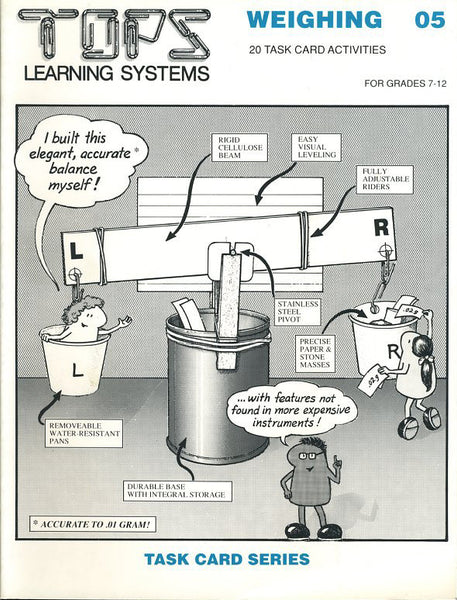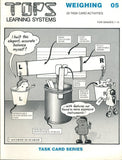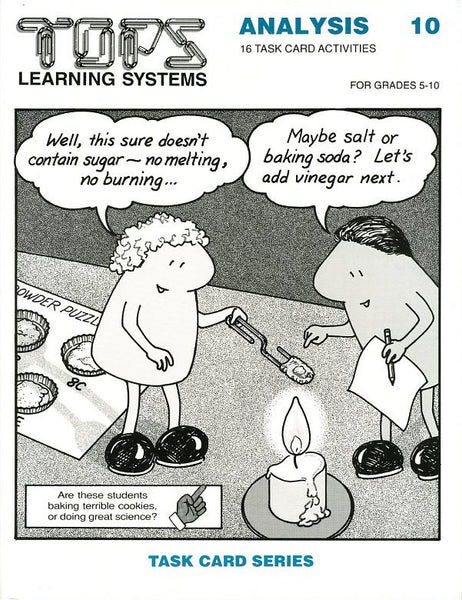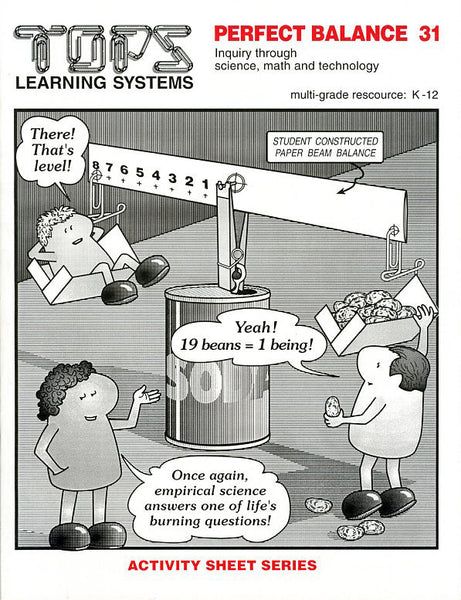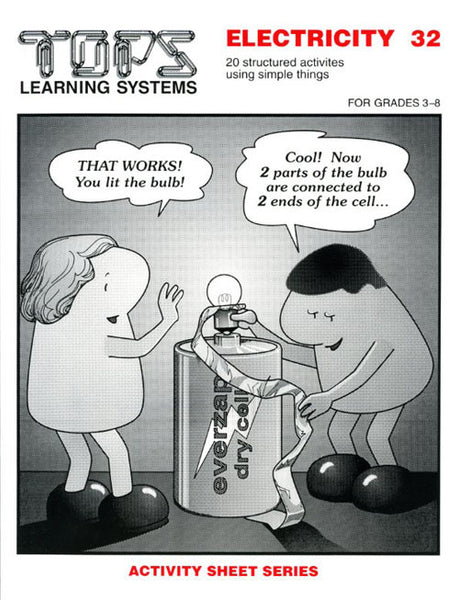#05 Weighing (grades 5-10)
Regular price $19.95
Soft-bound, 56 page book, 20 reproducible task cards, full teaching notes
This book is about science ownership. Students improvise a serviceable and sensitive gram balance that supports all TOPS activities requiring weight measure. The physics of balance equilibrium, centering, sensitivity, restoring forces, reproducibility, trueness, mass vs. weight, all get real on instruments that students build themselves.
More Information – click any of the tabs below to learn more about this title
Click here for a complete list of materials and convenient shopping.
scissors -- heavy-duty to cut corrugated cardboard, bottle white glue, lined index cards, corrugated cardboard at least 30 cm long (boxes or flat sheets), straight pins, boxes paper clips, wooden clothespins, medium-sized tin cans, rolls masking tape, paper punch tools, small paper drinking cups with flat bottoms, light-duty rubber bands, heavy-duty rubber bands, packages long-grained white rice, packages unpopped popcorn, packages pinto beans, coins of each kind: pennies, nickels, and dimes, cups oil-based clay — 1 cup = 1/2 pound, packages notebook paper, metric rulers, graduated cylinders — 10 ml capacity, water source, hand calculators (optional), cups clean, dry gravel, size-D batteries, dead or alive, meter sticks or yard sticks, birthday candles, books of matches, envelopes -- legal or personal size,
various: materials to use as a weight standard. Use whatever you have on hand. Useful items might include: thumbtacks, washers, beans, rice, straws, heavy string, clay, scissors, eyedroppers, spoons, a hole punch, large bowl
various: materials to use as a weight standard. Use whatever you have on hand. Useful items might include: thumbtacks, washers, beans, rice, straws, heavy string, clay, scissors, eyedroppers, spoons, a hole punch, large bowl
- Lesson 1: To begin building a sturdy, accurate equal-arm balance to use in all experiments that require weight measure.
- Lesson 2: To continue building a sturdy, accurate equal-arm balance to use in all experiments that require weight measure.
- Lesson 3: To finish building a sturdy, accurate equal-arm balance to use in all experiments that require weight measure. To learn how to center the balance and make accurate weighings.
- Lesson 4: To practice making accurate weight comparisons on a balance. To solve simple equations using long division.
- Lesson 5: To determine if the equal-arm balance weighs true. To recognize that bias results when the arms of a balance beam have unequal length.
- Lesson 6: To develop a weight standard based on paper clips.
- Lesson 7: To experimentally determine how high and low pivot positions on the balance beam affect its sensitivity and stability.
- Lesson 8: To accurately weigh 10 mL of water in paper clips. To use this result to establish an equivalency between paper clips and grams.
- Lesson 9: To trim a 20-lined sheet of notebook paper until it weighs 1 gram.
- Lesson 10: To cut a series of 9 paper weights from notebook paper, starting with one gram and working down to one-hundredth of a gram.
- Lesson 11: To tape a series of 7 rock weights together, starting with 2 grams and working up to 50 grams.
- Lesson 12: To practice making accurate weighings on an equal-arm balance by weighing coins to the nearest 0.01 gram.
- Lesson 13: To experimentally determine if the weight of the load affects the sensitivity of an equal-arm balance.
- Lesson 14: To graph how penny mass increases in direct proportion to number.
- Lesson 15: To construct a spring scale from rubber bands and calibrate it in grams.
- Lesson 16: To distinguish between weight that is measured on a spring scale and mass that is measured on an equal arm balance.
- Lesson 17: To measure how fast a birthday candle burns wax.
- Lesson 18: To devise a simple method for estimating postage rates. To develop a sense for how much an ounce weighs.
- Lesson 19: To invent a new weight standard for the equal-arm balance. To convert measure from this new standard back into grams.
- Lesson 20: To judge the outcome of a contest using the equal-arm balance. To have fun.
We encourage improvisation - it's one of the main goals of our hands-on approach! You and your students might invent a simpler, sturdier or more accurate system; might ask a better question; might design a better extension. Hooray for ingenuity! When this occurs, we'd love to hear about it and share it with other educators.
National Science Education Standards (NRC 1996)
Teachers of science...
A: ...plan an inquiry-based science program. (p. 30)
B: ...guide and facilitate learning. (p. 32)
C: ...engage in ongoing assessment of their teaching and of student learning. (p. 37)
D: ...design and manage learning environments that provide students with the time, space, and resources needed for learning science. (p. 43)
• Represent a central event or phenomenon in the natural world.
• Represent a central scientific idea and organizing principle.
• Have rich explanatory power.
• Guide fruitful investigations.
• Apply to situations and contexts common to everyday experiences.
• Can be linked to meaningful learning experiences.
• Are developmentally appropriate for students at the grade level specified.
Core Concepts/Processes: An equal-arm balance measures mass. A spring balance measures weight.
Core Inquiries:Understand the nature of balance sensitivity and instrument bias. • Distinguish between weight and mass.
Core Content: Balance equilibrium • Centering • Sensitivity and stability • Sensitivity and load • Restoring forces • Reproducibility • Trueness • Mass and weight
Core Content: Build an equal arm balance sensitive to 0.01 grams.
TEACHING Standards
These 20 Activity Sheets promote excellence in science teaching by these NSES criteria:Teachers of science...
A: ...plan an inquiry-based science program. (p. 30)
B: ...guide and facilitate learning. (p. 32)
C: ...engage in ongoing assessment of their teaching and of student learning. (p. 37)
D: ...design and manage learning environments that provide students with the time, space, and resources needed for learning science. (p. 43)
CONTENT Standards
These 20 Activity Sheets contain fundamental content as defined by these NSES guidelines (p. 109).• Represent a central event or phenomenon in the natural world.
• Represent a central scientific idea and organizing principle.
• Have rich explanatory power.
• Guide fruitful investigations.
• Apply to situations and contexts common to everyday experiences.
• Can be linked to meaningful learning experiences.
• Are developmentally appropriate for students at the grade level specified.
Unifying Concepts and Processes
NSES Framework: Systems, order, and organization • Evidence, models and explanation • Constancy, change, and measurement • Evolution and equilibrium • Form and functionCore Concepts/Processes: An equal-arm balance measures mass. A spring balance measures weight.
Science as Inquiry (content standard A)
NSES Framework: Identify questions that can be answered through scientific investigations. • Design and conduct a scientific investigation. • Use appropriate tools and techniques to gather, analyze, and interpret data. • Develop descriptions, explanations, predictions, and models using evidence. • Think critically and logically to make the relationships between evidence and explanations. • Recognize and analyze alternative explanations and predictions. • Communicate scientific procedures and explanations. • Use mathematics in all aspects of scientific inquiry.Core Inquiries:Understand the nature of balance sensitivity and instrument bias. • Distinguish between weight and mass.
Physical Science (content standard B)
NSES Framework: Properties and changes of properties in matter • Motions and forcesCore Content: Balance equilibrium • Centering • Sensitivity and stability • Sensitivity and load • Restoring forces • Reproducibility • Trueness • Mass and weight
Science and Technology (content standard E)
NSES Framework: Abilities of technological design • Understanding about science and technologyCore Content: Build an equal arm balance sensitive to 0.01 grams.

